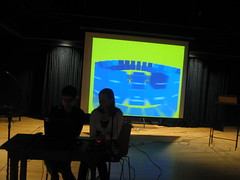Authentic Interactive Characters To Solve Violence in Games Controversy
[Note: I timestamped this post 11:59pm March 31, so you’d know I wasn’t joking.]
There was sometimes fascinating, sometimes frightening testimony at a U.S. Senate hearing last Wednesday on the effects of violence in games. One of the only voices suggesting that the social science data is perhaps not yet conclusive was UIUC prof Dmitri Williams, who blogs at GTxA compatriot site Terra Nova. (Interestingly Williams’ was the only testimony not available to the press as of yesterday; luckily Williams has posted his statement on his site, along with everyone else’s.)
Violence in games is not something we usually talk about on this blog; we’re more interested in the aspects of human behavior typically not represented or simulated to date in interactive entertainment (1 2 3 4 5 6 7, for example). When we do occasionally talk about violence, it might be about how it seems to seep its way into character-centric interactive entertainment experiences, how violence is such a one-note tune in contemporary game design or in media coverage of games, maybe how life can eerily imitate game violence, or meta-commentaries on violence in life vs. games, or the military’s involvement in gaming (1 2 3), or perhaps to expose the occasional violent debate between game scholars.
An axe I often grind is the need for what I’ve called “authentically interactive” characters and stories — how we need them for the medium to progress and mature, for creative, artistic and aesthetic reasons.
But couldn’t authentic characters also be the salvation for the violence in games crisis?



 While we don’t normally write personal blog entries on GTxA, I’ll follow
While we don’t normally write personal blog entries on GTxA, I’ll follow  Articles covering the still-ongoing Game Developers Conference are flowing in:
Articles covering the still-ongoing Game Developers Conference are flowing in: 




